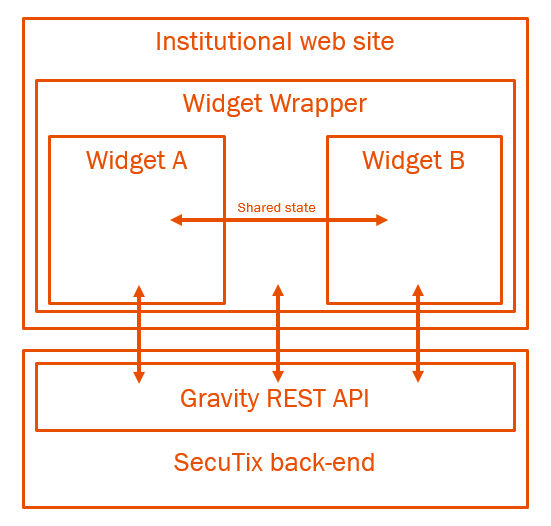- Created by FMR, last modified on Feb 22, 2018
Disclaimer
The documentation made available here is the official documentation concerning the Gravity project, the Gravity Widgets and the corresponding underlying REST API. It contains detailed documentation of the integration possibilities, with examples.
The documentation is still in alpha stage.
Quick access to documentation
Build a rich online sales front-end with Gravity Widgets and REST API integrations
SecuTix offers a new way to build online sales front-ends based on Gravity technologies. The aim of this project is to offer a set of tools that provide increased flexibility for online front-end interfaces. The basic building blocks of Gravity are called Widgets: isolated components that can be integrated and arranged in fully custom ways and in any web page. Every Widget handles a particular business case as a whole. Think for instance about the business case of selecting an event in the SecuTix catalog: a standalone Widget will represent this business case and may be integrated in any web page, customized in the display and behavior. Moreover, widgets will share a complete application state, and be able to communicate within each other.
The final goal of Gravity will be to provide all Widgets that are necessary to build a fully customized online sales funnels.
Please note that the project is currently in its early stages, and will span for a period of at least two years before its completion. Widgets will be shipped in every SecuTix release, in a decreasing order of value. This reference page will be regularly enhanced to contain all the information of currently available and future Widgets.
Gravity roadmap
As stated in the previous section, Gravity is an ongoing project. The project is setup in two streams that run in parallel. In the first stream, basic components and Widgets are being created to progressively replace the classic online sales components of SecuTix. The second stream will take advantage of these new technologies to provide innovative tools.
In the first stream, Widgets are being shipped in a decreasing order of value, giving privilege to the parts of online sales that require the most customization possibilities. In the following diagram, a decomposition of the online sales process is shown with provisional delivery dates (subject to change). Please refer to the following presentation for more details on the current Gravity planning: Gravity - Scope and Planning 2018.pdf

Architecture
Gravity is based on the design and implementation of the online sales module of SecuTix. This module already supports the aggregation of information and operations required to perform sales online. On top of this back-end implementation, a new REST API is designed to handle simplified communication between a modern single-page application front-end.
The front-end is now completely separated and implemented with modern JavaScript technologies; it is not linked anymore to server-side rendering as the current online sales. This offers the possibility of extracting the visual interface from the system, and integrate it in any third party web-site. Widgets are based on this assumpions, and are self-contained elements. Moreover, a wrapper is available on top of every widget, to orchestrate the communication between the different components that can be included in a web page.
As previously stated, a Widget is based on standard SecuTix front-end components, and it is responsible of handling completely a particular business scenario. The display is automatically handled by taking into account the standard theme applied to the online point of sales it is linked to, and follows the guidelines of the Equilibrium design. Every element of the Widget can be restyled, by appying CSS instructions. Moreover, a set of customization parameters allow further adaptation of the Widget look and feel.
A choice of granularity is indeed possible, to satisfy and need for integration. Widgets, as just underlined, can be customized in their look and feel. When this is not sufficient, an access to the underlaying REST API is made available to allow the reconstruction of the front-end part.

High level Gravity architecture
Documentation
The full documentation of the Gravity REST API can be found at the following link: Gravity REST API. Basic architectural consideration and interactive documentation are available.
The detailed documentation of available widgets can be found here: Gravity Widgets. Every widget is presented and an interactive documentation is available.